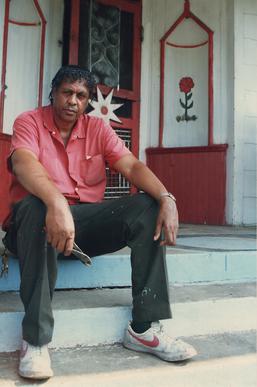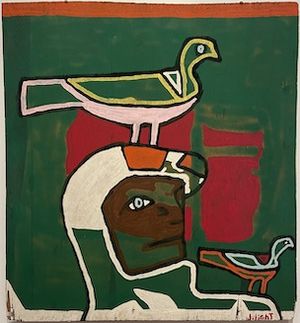Joe Louis Light facts for kids
Quick facts for kids
Joe Light
|
|
|---|---|

Joe Light on his front porch outside of Memphis, Tennessee
|
|
| Born |
Joe Louis Light
1934 |
| Died | 2005 (aged 70–71) |
| Nationality | American |
| Known for | Painting |
| Movement | Modern Art |
Joe Louis Light (1934–2005) was an American painter from Dyersburg, Tennessee. His art often explored ideas about finding spiritual understanding and the balance of the universe.
Contents
Life Story of Joe Light
Joe Light grew up on a farm in Tennessee with his parents, Virgie Mary and Hiawatha. They named him after Joe Louis, a famous boxer and a hero for African Americans during the Jim Crow Era. This was a time when laws in the Southern United States kept Black people and white people separate and unequal.
Joe left home when he was young. He finished school up to the eighth grade. He worked on farms until he joined the army in 1951. However, he left the army later that year. After leaving the military, he spent time in prison. During his first time in prison, Joe met a Rabbi and became Jewish. He felt that what he learned from the Old Testament made a lot of sense to him.
Joe Light was married twice. He had two children from his first marriage. Later, he married Rosie Lee Cotton in 1968. They raised ten children together near Memphis, Tennessee.
For work, Joe rented a space at a local flea market. He would fix up old items and sell them. He never sold his paintings or signs at the market. Joe was a private person who mostly stayed at home. But he strongly believed in sharing his ideas about justice and morality, which came from the Old Testament. He felt he had answers to the world's problems.
Joe Light passed away on August 6, 2005, when he was 70 years old. He is buried in a veterans' cemetery.
Joe Light's Art Career
Joe Light started making art after he became Jewish. As he traveled, he began writing moral codes and Bible verses on public walls. This helped him develop his unique style of making signs. After he married Rosie Lee Cotton and settled in Memphis in 1970, his home became his main place for sharing his messages. He painted ethical rules and stories on the shutters and sides of his house.
Art Materials Joe Light Used
Light often used materials he found. For some of his sculptures, he used driftwood from the Mississippi River. He also used old TV sets and hubcaps for his paintings and mixed-media artworks. Many of his paintings were made with house paint on thin pieces of plywood.
What Inspired Joe Light's Art
His personal faith and religion were Joe Light's biggest inspirations. He moved away from the Baptist faith of his youth. Instead, he developed his own beliefs, shaped by the unfair treatment he saw during the pre-Civil Rights era in the South.
Joe Light was also influenced by Pop art and the advertising of the mid-1900s. His paintings often show outlines of landscapes or people in black, filled with bright, bold colors. Some art experts believe his Pop Art-inspired style came from seeing so many advertisements. He sold and fixed up common goods at the market, which exposed him to lots of branding.
Sometimes, his spiritual and commercial inspirations mixed. For example, in his painting Hobo # Birdman (1988), a character called the Hobo walks toward two store-bought postcards that are part of the painting. Another painting inside his home showed Pebbles and Bamm-Bamm, characters from The Flintstones cartoon, riding a serpent through a garden.
Joe Light's Home as Art
Before Joe Light made separate paintings and sculptures, he decorated his home with his art and messages. The outside of his house clearly showed his beliefs about race, politics, and spirituality to anyone passing by. He used clear English words or bold pictures so people could easily understand his messages.
Joe rarely talked to the public in person. He made sure his yard and home were secure so no one could enter without his permission. He wanted to protect his African American Jewish children from the dangers of the outside world. He had experienced a lot of unfairness in his life and wanted to shield his children from it.
Inside his home, he wrote messages on the walls in a special script he called "Abraham's language." The paintings inside his house were more abstract and harder to understand a clear religious story from. He saw himself as a guide, leading himself and his family toward a better future.
Repeating Images in Joe Light's Art

Two characters, the Hobo and the Birdman, appear often in Joe Light's artwork. Both come from his own journey to find spiritual understanding.
The Hobo represents someone who is searching for meaning and hasn't yet found enlightenment. Joe Light painted four versions of the Hobo: one black, one white, one red, and one yellow. This showed his idea of different cultures. He often placed the Hobo in nature, like by a river or mountains. These natural settings represent the challenges the Hobo must overcome to find understanding.
The Birdman is the opposite of the Hobo. He represents someone who has found enlightenment. When Joe Light first felt God calling him to Judaism, a bird flew into his prison cell window. For Joe, the bird became a symbol of a message from God. You can often see the Hobo and the Birdman together in the same painting. This shows that one needs the other on their spiritual journey.
Exhibitions of Joe Light's Art
Joe Light's art has been shown in many places, including:
- Outside the Mainstream: Folk Art in Our Time. 1988, High Museum of Art. Atlanta, GA.
- Ashe: Improvisation and Recycling in African-American Visionary Art. 1993. Diggs Gallery - Winston-Salem State University. Winston-Salem, NC.
- Passionate Visions of the American South: Self- Taught Artists, 1940 to the Present. 1993-1994 New Orleans Museum of Art. New Orleans, LA.
- Pictured in my Mind: Contemporary American Self-Taught Art from the Collection of Dr. Kurt Gitter and Alice Rae Yelen. 1996, Birmingham Museum of Art, Birmingham, AL.
- Wind in my Hair. 1996-1997, American Visionary Art Museum. Baltimore, MD
- Noah's Ark: Animals by Southern Self-Taught Artists. 1998. Art Museum of the University of Memphis. Memphis, TN.
- Let it Shine: Self-Taught Art from the T. Marshall Hahn Collection. 2001. High Museum of Art. Atlanta, GA.
- Testimony: Vernacular Art of the African-American South. 2001. Kalamazoo Institute of Art. Kalamazoo, MI.
- Revelations: Art from the African American South. 2017-2018. De Young Museum. San Francisco, CA.
- History Refused to Die. 2018. Metropolitan Museum of Art. New York, NY.
- Called to Create: Black Artists of the American South. 2022-2023. National Gallery of Art. Washington, DC.
Where to See Joe Light's Art
Joe Light's artwork is part of the permanent collections in these museums:
- Fine Arts Museums of San Francisco
- Metropolitan Museum of Art
- High Museum of Art
- New Orleans Museum Of Art
- Rockford Art Museum
- Birmingham Museum of Art
- Milwaukee Art Museum
- Museum of Fine Arts Houston
- Gadsden Arts Center and Museum
- Ackland Art Museum
- Smithsonian American Art Museum.

